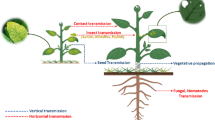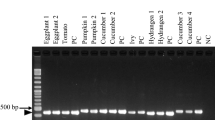Abstract
Double-stranded RNAs (dsRNAs) have been found in two isolates of the plant pathogenic fungus Fusarium graminearum which produce trichothecene mycotoxins. The isolates 8.2 and 19.2 had dsRNAs in the size of about 2.0 kb and 6.0 kb, respectively, which were associated with capsid proteins and persisted within the cytoplasm of the infected host cells as encapsidated virus-like particles (VLPs). The dsRNAs contained in the VLP pellets were the same size as the dsRNA isolated in total nucleic acid preparations. In the VLP pellets the isolate 19.2 had a second dsRNA with the size of about 1.6 kb. After mycovirus purification one icosahedral particle of about 28 nm in diameter from the isolate 8.2 and two icosahedral particles of about 28 nm and 38 to 40 nm in diameter from the isolate 19.2 could be identified with electron microscopy. SDS-PAGE analysis of the VLPs from the isolate 8.2 revealed one major protein component of approximately 65 kDa, while the isolate 19.2 had two major protein bands at about 94 kDa and 105 kDa. Both isolates were studied for potential trichothecene production. Tox5 PCR showed a 658 bp fragment in each isolate. In addition, both strains were able to produce the trichothecenes deoxynivalenol (DON), the derivatives acetyl-DON (3-A-DON, 15-A-DON) and nivalenol (NIV) in vitro.
Similar content being viewed by others
References
Fekete C, Giczey G, Papp I, Szabó L, Hornok L (1995) High-frequently occurrence of virus-like particles with double-stranded RNA genome in Fusarium poae. FEMS Microbiol. Lett. 131: 295–299.
Nogawa M, Shimosaka M, Kageyama T, Okazaki M (1993) A double-stranded RNA mycovirus from the plant pathogenic fungus, Fusarium solani f. sp. robiniae. FEMS Microbiol. Lett. 110: 153–158.
Sambrook J, Fritsch EF, Maniatis T (Eds) (1989) Molecular cloning: a laboratory manual. Cold Spring Harbor Laboratory Press, Cold Spring Harbor, New York.
Vilches S, Castillo A (1997) A double-stranded RNA mycovirus in Botrytis cinerea. FEMS Microbiol. Lett. 155: 125–130.
Niessen ML, Vogel, RF (1998) Group specific PCR-detection of potential trichothecene-producing Fusarium-species in pure cultures and cereal samples. System. Appl. Microbiol. 21: 618–631.
Walker F, Meier B (1998) Determination of the Fusarium mycotoxins nivalenol, deoxynivalenol, 3-acetyldeoxynivalenol, and 15-acetyl-4-deoxynivalenol in contaminated whole wheat flour by liquid chromatography with diode array detection and gas chromatography with electron capture detection. J. AOAC 81: 741–748.
Valverde RA, Nameth ST, Jordan RL (1990) Analysis of double-stranded RNA for plant virus diagnosis. Plant Dis. 74: 255–258.
Author information
Authors and Affiliations
Rights and permissions
About this article
Cite this article
Theisen, S., Röseler, S., Berger, S. et al. Analysis of double-stranded RNA and virus-like particles in trichothecene-producing strains ofFusarium graminearum . Mycotox Res 17 (Suppl 1), 32–36 (2001). https://doi.org/10.1007/BF03036707
Published:
Issue Date:
DOI: https://doi.org/10.1007/BF03036707




